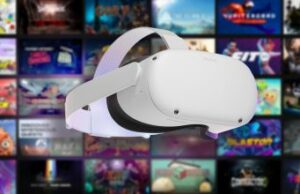Meta released the v50 update for Quest 2, bringing to the standalone some new experimental features that not only aim to make hand-tracked UI navigation a little more natural, but also bring 2D app multitasking to Quest 2 for the first time.
One of the headlining features of v50 is something Meta is calling ‘Direct Touch’, which lets you tap and swipe through the Home UI. Simply ‘touch’ the tile and manipulate the menu like you would on a phone or tablet, Meta says, something that sounds a little more natural than pinching tiles from a distance in mid-air.
Meta says in a blog post that Direct Touch brings Quest “closer to that more intuitive hands-on future” that it hoped to bring when it first integrated optical hand tracking in 2019. Check out how it works in the gif below:
“We’ve reworked the Meta Quest UI so that—once you enable Direct Touch—you can tap buttons with your index finger to adjust your Settings or select a game from your library, quickly type out messages on the virtual keyboard, and more,” Meta says.
You can opt-in by navigating to the ‘Experimental Settings’ tab in-headset and turning on the ‘Direct Touch’ toggle, of course provided v50 has already rolled out to your device.
Meta’s v50 update also includes a new Quest 2 feature previously exclusive to Quest Pro: in-game multitasking. This lets you navigate to 2D apps, such as a browser, without closing the VR app you currently have open. Effectively, this means you can stay in-headset while you browse game walkthroughs, check your email, or whatever else you can do in a 2D app, all while still in-game.
As for Quest Pro, Meta says v50 has also reduced the amount of time it takes for tracking to initialize on the Meta Quest Touch Pro controllers—something oft lamented by early adopters due to the controllers’ inside-out tracking capabilities, which need to find their bearings in the room first.
Meanwhile, v50 marks the last time Meta is shipping new features to Quest 1. The company says in the release notes that while Quest 1 owners will be able to use their headsets beyond 2024, users will no longer be able to create or join a party; Quest 1 users who currently have access to Meta Horizon Home social features will lose access to these features on March 5, 2023—which means you also won’t be able to invite others to your Home or visit someone else’s Home.
With Quest 1 seemingly in the dustbin, Meta appears to be focusing on unifying some of the feature sets between Quest 2 and Quest Pro while polishing the software experience before the release of its next headset, Quest 3.
Earlier this month, Meta affirmed plans to release a Quest 3 headset at some point this year, something the company calls a mixed reality headset, inviting comparisons to Quest Pro—albeit without the face-tracking of the latter due to its relative cost, Meta says.



